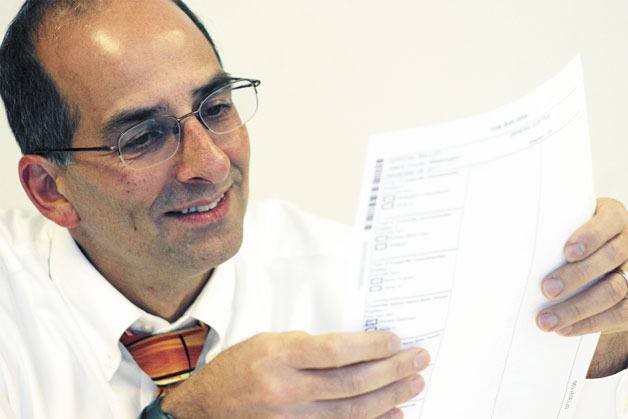COUPEVILLE — What were voters thinking?
Three top Island County officials spent a little more than an hour Wednesday trying to sort that out.
No, they weren’t wondering why some candidates got the nod, and others got the gate.
Instead, Island County Commissioner Angie Homola, Prosecutor Greg Banks and Auditor Sheilah Crider — the three members of the county’s canvassing board — met to scrutinize ballots that had been rejected from the initial vote count on Election Night.
The trio reviewed 25 ballots, some where more than one box had been marked in the same contest, others with errant marks hither and yon, and others that had deliberate and dark marks that then faded away toward the end of the ballot.
The board members referred often to a thick booklet with guidelines on how to determine the intent of the voter, complete with illustrations on the many ways that voters can botch a ballot.
One by one, the board worked their way through an envelope filled with bad ballots.
The quips came quickly.
Banks held up one ballot, and pointed out a race where a voter had chosen both candidates.
“That was a husband-and-wife effort,” joked Homola.
On the next ballot, the first boxes were blackened and nearly completely filled, but by the end of the ballot, the voter started using X-marks instead.
“It feels like voter fatigue,” Crider said.
Maybe the voter was going to give up after voting in the first races, Banks guessed with a grin, then powered through the rest of the ballot.
“They drank a five-hour energy drink,” he qupped.
On other ballots, no explanation could be found on what the voter was thinking. Was a little mark next to a box a vote? Or an errant swipe of the pen?
“They’re playing with us,” Homola said after one especially perplexing ballot.
At the end of the meeting, the trio looked at a short stack of ballots, five in all, that had come through the county’s interoffice mail Wednesday, a day late.
The ballots weren’t postmarked, so there was no way to tell when they were filled out.
Still, they ballot envelopes had all been signed on Election Day or the day before. Could they be counted?
“We don’t know that they weren’t dropped in the [interoffice] mail this morning,” Crider said. “There is no postmark.”
Deputy Auditor Michele Reagan recalled how she had seen a woman on Election Night trying to stuff a ballot into the curbside box well after the polls had closed, and how another woman came in Wednesday with a handful of ballots and tried to drop them off.
None of those ballots were accepted, she said.
Crider also said county employees shouldn’t be using a non-secure system such as interoffice mail to get their ballots over to the election office. She vowed to send an email to employees warning them not to do that in the future.
In the end, the five ballots were rejected.
“I don’t see how we can count them,” Homola said.
“I think it’s unfortunate. They fully intended to vote.”
The canvassing board will meet once more before the 2011 General Election is validated Monday, Nov. 28, to review ballots that have signature issues or late postmarks.
The next vote count is planned for Thursday, Nov. 17.
Election workers expect there will be 50 ballots to count. That estimate includes ballots that may come in the mail that are postmarked by Election Day or earlier, and ballots that have issues with validation signatures that must be resolved before the ballots can be counted.



